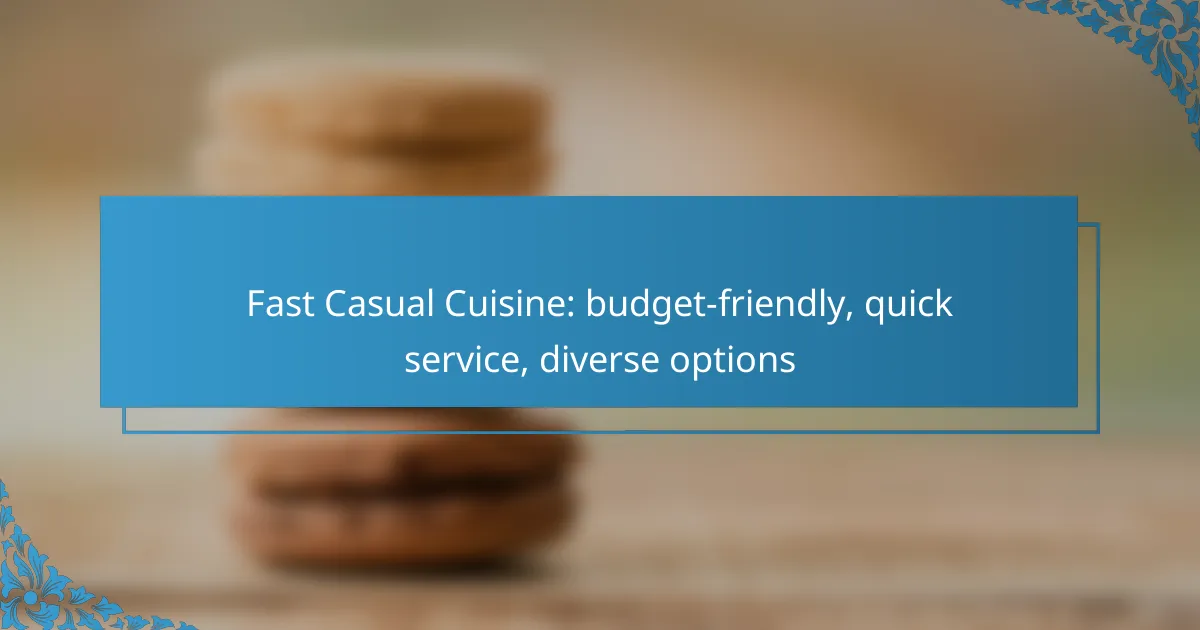Fast casual cuisine strikes a perfect balance between quick service and quality, offering a diverse array of budget-friendly options. With a focus on fresh ingredients and flavorful dishes, these establishments cater to busy lifestyles while ensuring a satisfying dining experience. From popular chains to local gems, fast casual dining provides a convenient way to explore various culinary delights without breaking the bank.

Where to find fast casual cuisine in Los Angeles?
Los Angeles offers a vibrant fast casual dining scene, featuring a mix of popular chains, local favorites, and food trucks. These establishments provide budget-friendly meals with quick service, making them ideal for busy lifestyles.
Popular chains like Chipotle and Panera Bread
Fast casual chains such as Chipotle and Panera Bread are widely available throughout Los Angeles, offering a consistent menu and quick service. Chipotle specializes in customizable burritos and bowls, while Panera Bread is known for its fresh salads and bakery items.
Prices at these chains typically range from $8 to $15 per meal, making them accessible for most budgets. Both chains emphasize quality ingredients, which appeals to health-conscious diners.
Local favorites such as Mendocino Farms
Mendocino Farms is a standout local chain in Los Angeles, known for its gourmet sandwiches and salads made from locally sourced ingredients. The menu features seasonal items that change frequently, providing a unique dining experience.
Expect to pay around $10 to $15 for a meal at Mendocino Farms, which is competitive with other fast casual options. The emphasis on fresh, high-quality ingredients sets it apart from larger chains.
Food trucks offering diverse options
Los Angeles is famous for its food trucks, which offer a wide variety of fast casual cuisine. From gourmet tacos to fusion dishes, these mobile eateries provide diverse options at affordable prices, typically ranging from $5 to $15 per item.
Food trucks often gather at popular locations or events, making it easy to sample different cuisines in one outing. Keep an eye on social media for truck schedules and special menu items to make the most of your dining experience.

What are the budget-friendly options for fast casual dining?
Budget-friendly options for fast casual dining include value menus, daily specials, and combo meals that provide substantial savings without sacrificing quality. These choices allow diners to enjoy diverse cuisines while keeping costs manageable.
Value menus at major chains
Many fast casual chains offer value menus featuring items priced around $5 to $10. These menus typically include smaller portions or simplified dishes, making them an excellent choice for budget-conscious diners. Popular chains like Taco Bell, Wendy’s, and McDonald’s frequently update their value offerings to attract customers.
When selecting from value menus, consider the nutritional content and portion sizes. While these options are affordable, they may not always provide the best balance of nutrients. Look for items that include vegetables or lean proteins to enhance your meal.
Daily specials at local eateries
Local fast casual restaurants often have daily specials that can significantly reduce your dining costs. These specials may include discounted meals, buy-one-get-one-free offers, or unique dishes available only on specific days. Checking social media or the restaurant’s website can help you stay informed about these deals.
Take advantage of loyalty programs at local eateries, as they may offer exclusive discounts or rewards for frequent customers. This can lead to even greater savings over time, especially if you dine out regularly.
Combo meals for cost savings
Combo meals are a popular way to save money at fast casual restaurants, typically bundling an entrée with sides and a drink for a lower price than ordering each item separately. Prices for combo meals usually range from $8 to $15, depending on the restaurant and location.
When choosing combo meals, compare the individual prices of items to ensure you’re getting a good deal. Some restaurants allow customization of combo meals, so you can select healthier sides or drinks that fit your dietary preferences while still enjoying savings.

How does fast casual cuisine compare to fast food?
Fast casual cuisine offers a middle ground between fast food and traditional dining, focusing on higher quality ingredients and a more diverse menu. While fast food emphasizes speed and low prices, fast casual restaurants prioritize a better dining experience without sacrificing convenience.
Higher quality ingredients
Fast casual establishments typically use fresher, higher quality ingredients compared to standard fast food outlets. This often includes locally sourced produce, antibiotic-free meats, and organic options, which can enhance both flavor and nutritional value.
For example, a fast casual burger may feature grass-fed beef and whole grain buns, while a fast food burger might rely on processed ingredients. This commitment to quality can lead to a more satisfying meal experience.
More diverse menu options
Fast casual cuisine is known for its wide variety of menu options that cater to different dietary preferences and tastes. Diners can often find choices ranging from vegetarian and vegan dishes to gluten-free and low-calorie meals.
This diversity allows customers to enjoy meals that align with their dietary needs, making it easier to dine out without compromising on personal health goals. For instance, a fast casual restaurant might offer customizable salads, burritos, and grain bowls, appealing to a broader audience.
Faster service than traditional dining
Fast casual restaurants provide quicker service than traditional sit-down dining, typically allowing customers to order at a counter and receive their meals in a matter of minutes. This speed is comparable to fast food, but with the added benefit of a more relaxed atmosphere.
While wait times can vary, many fast casual spots aim for service within 10-15 minutes, making them ideal for lunch breaks or casual dinners. Customers can enjoy a comfortable dining experience without the lengthy wait associated with full-service restaurants.

What are the health benefits of fast casual cuisine?
Fast casual cuisine offers several health benefits, primarily due to its focus on fresh ingredients and customizable options. Diners can choose meals that align with their dietary preferences, making it easier to maintain a balanced diet while enjoying quick service.
Fresh ingredients and customizable meals
Fast casual restaurants often prioritize fresh, high-quality ingredients, which can enhance the nutritional value of meals. Many establishments allow customers to customize their dishes, enabling them to select healthier options such as whole grains, lean proteins, and a variety of vegetables.
For example, a salad bar at a fast casual eatery lets you build a meal tailored to your taste and health goals, ensuring you get the nutrients you need while avoiding unwanted additives.
Healthier cooking methods
Fast casual cuisine typically employs healthier cooking methods compared to traditional fast food. Techniques such as grilling, steaming, and roasting are common, which can help retain nutrients and reduce the need for excessive fats and oils.
Choosing grilled chicken over fried options can significantly lower calorie intake and unhealthy fat consumption, making it easier to enjoy satisfying meals without compromising health.
Dietary options for various needs
Many fast casual restaurants cater to diverse dietary needs, offering vegetarian, vegan, gluten-free, and low-carb options. This inclusivity allows diners with specific health concerns or preferences to find suitable meals without feeling restricted.
When dining out, look for menus that clearly indicate dietary options, making it easier to select meals that align with your nutritional goals. This flexibility is particularly beneficial for those managing conditions like diabetes or food allergies.

What are the key attributes of fast casual restaurants?
Fast casual restaurants combine the convenience of quick service with a focus on quality food and a diverse menu. They typically offer a more relaxed dining atmosphere than fast food, while still being budget-friendly and efficient.
Quick service model
The quick service model in fast casual restaurants emphasizes speed without sacrificing food quality. Customers usually order at a counter and receive their meals within a few minutes, allowing for a fast dining experience.
This model is designed to cater to busy individuals and families looking for a meal on the go. Many establishments also offer online ordering and takeout options to enhance convenience.
Affordable pricing
Fast casual restaurants are known for their affordable pricing, typically ranging from low single digits to low double digits in USD. This makes them accessible to a wide audience, including students and working professionals.
While prices can vary based on location and menu items, the focus remains on providing value for money. Many places offer combo meals or specials to help customers save even more.
Diverse menu offerings
Diverse menu offerings are a hallmark of fast casual dining, featuring a mix of cuisines and dietary options. Customers can often find everything from salads and sandwiches to ethnic dishes and vegan choices.
This variety caters to different tastes and dietary needs, making it easier for groups with varying preferences to dine together. Seasonal specials and local ingredients are also common, adding to the appeal of the menu.

What factors should you consider when choosing a fast casual restaurant?
When selecting a fast casual restaurant, consider factors like menu variety, price range, and service speed. These elements significantly impact your dining experience and can help you find a spot that fits your needs and budget.
Location and accessibility
Location plays a crucial role in choosing a fast casual restaurant. Look for places that are conveniently situated near your home, workplace, or popular gathering spots. Accessibility can also include parking availability and proximity to public transportation.
Consider the surrounding area as well; a restaurant in a busy district may offer more vibrant options but could also mean longer wait times. Check if the restaurant is in a safe neighborhood, especially if you plan to visit during evening hours.
Using apps or websites that provide maps and user reviews can help you gauge accessibility and find the best locations. Aim for restaurants that are within a reasonable distance, ideally no more than a 15-minute drive or a short walk.
